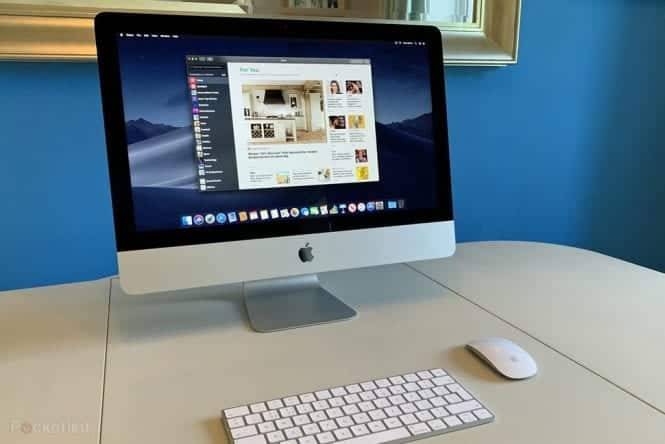At first glance, using an iMac without a mouse might seem complicated, if not impossible. However, there are some tricks to control the iMac even if the mouse suddenly dies. This article assumes that everything works well with your keyboard. Needless to say, the following hacks are simple and mainly concern the use of keyboard shortcuts. However, even if the keyboard disappoints you, it’s better to buy another one because you won’t be able to use iMac. Without further ado, let’s immerse ourselves immediately in the article.
HandShaker, how to transfer your data between Android and Mac
BEFORE YOU BEGIN
It is advisable to ensure that “Full keyboard access” is enabled. With this, you can use the Tab key to switch between dialog box controls. Otherwise, you would be able to switch between lists and text boxes. Most mouse-free browsing works without this step, but it’s better to enable it anyway.
Access the keyboard from System Preferences. Press Cmd + Space, type keyboard and press Enter. Switch to the Shortcuts tab and press Ctrl + F7 to select “All controls”. (On some iMacs, it could be Fn + Ctrl + F7.) Now you can use the Tab key to switch from one option to another and select them by pressing Space.
PASS THROUGH THE OPEN APPS
Press Cmd + Tab and you will be able to browse all the running apps. Continue to press Tab to reach the app you want to access. You can press the Down button to view all open windows within a particular app. Go to the window you want to access using the arrow keys and press Enter to select.
If you want to switch from an app to a full window, hold down Ctrl + Left Arrow or Right. To preview all open windows (not full screen), you need to press Ctrl + Up or Down.
It is likely that you will have to use Finder without the mouse. To start Finder, access Spotlight by pressing Cmd + Space, then type Finder and press Enter.
Use the arrow keys to access the Go menu in the menu bar. Press the down arrow to select a specific destination, such as Recent, Download, iCloud Drive, etc. Press Enter to enter and use the arrow keys to navigate further.
To access a specific folder, you need to use the arrow keys again, Up and Down to navigate and Left and Right to open the folder. If your folders are in thumbnail preview, use Cmd + Down to open a folder and Cmd + Su to go back. This also works with other types of folder preview.
Reminder: use Spotlight (Cmd + space) to access any app, file or folder without the mouse.
Once again, you can open Safari via Spotlight or switch to it using window browsing tricks. To access a website from the bookmarks bar, press Cmd + Bookmark number. For example, if the TechJunkie website is the first bookmark in the list, press Cmd + 1.
A new tab will open if you press Cmd + T and you can alternate with the tabs with Cmd + Shift + Left / Right arrow.
THE DOCK AND APP MENU BAR
The app menu bar is easy to select and navigate with the arrow keys and you can choose an item by pressing Enter or Space. To access the app menu directly, press Fn + Ctrl + F2, then go ahead with the arrow keys as described.
You can access the Dock with the Fn + Ctrl + F3 combination on the new iMacs. For older models, it’s just Ctrl + F3. And again, move left and right with the arrow keys and select with the Enter or Space keys.
HOW TO MANAGE THE TEXT DOCUMENTS
Once understood, you might prefer to use shortcuts rather than the mouse to move around in a text document. Here is a list of the most useful shortcuts.
CURSOR MOVEMENT
- Cmd + Up- upper part of the document.
- Cmd + Left – start of a line.
- Cmd + Right – end of a line.
- Option + Up – start of a paragraph.
- Option + Left – start of a word.
- Shift + Arrow keys- text selection.
COPY AND PASTE
- Cmd + C – to copy the selection.
- Cmd + V – to paste the selection.
- Cmd + X – to cut it.
- Cmd + A – to select all.
CHANGE STYLE TEXT
- Cmd + U- underlines the selected text.
- Cmd + B – the selected text is bold.
- Cmd + I- the text is in italics.
OTHER USEFUL SHORTCUTS
The following list of shortcuts is system-level and works in most applications, although there are some variations.
- Cmd +, – to access the app’s preferences.
- Cmd + O – to open a file.
- Cmd + W- closes a tab or a window.
- Cmd + N – to open a new window (new playlist in iTunes).
- Cmd + S- save a file.
- Cmd + P – to print a file.
MAGIC TRACKPAD
Long-term iMac users know that the Magic Trackpad is sometimes better than a mouse. It doesn’t take long to get used to all the navigation steps and customize most of the trackpad functions. This is why you might consider getting a trackpad even if your mouse is fine.

